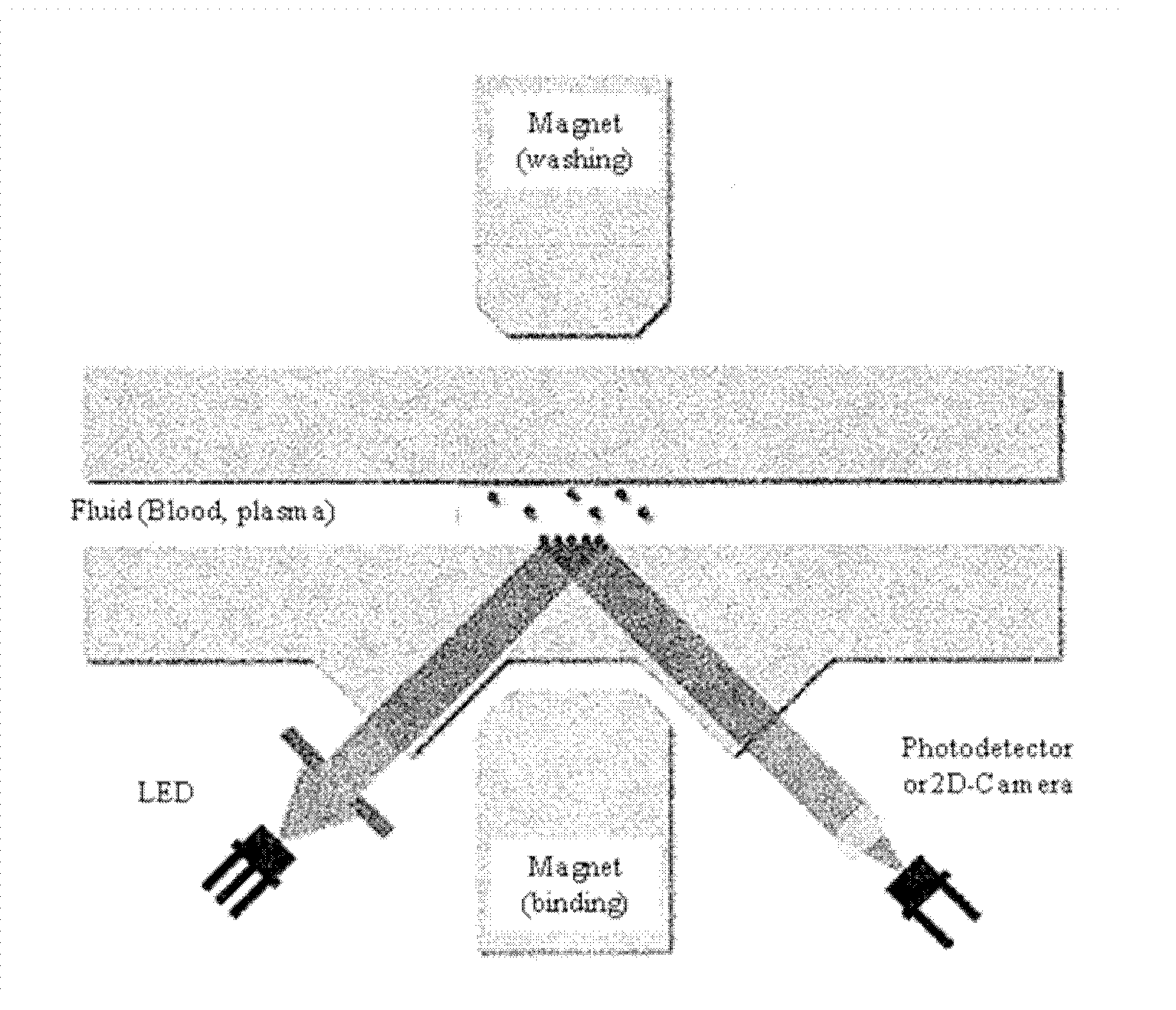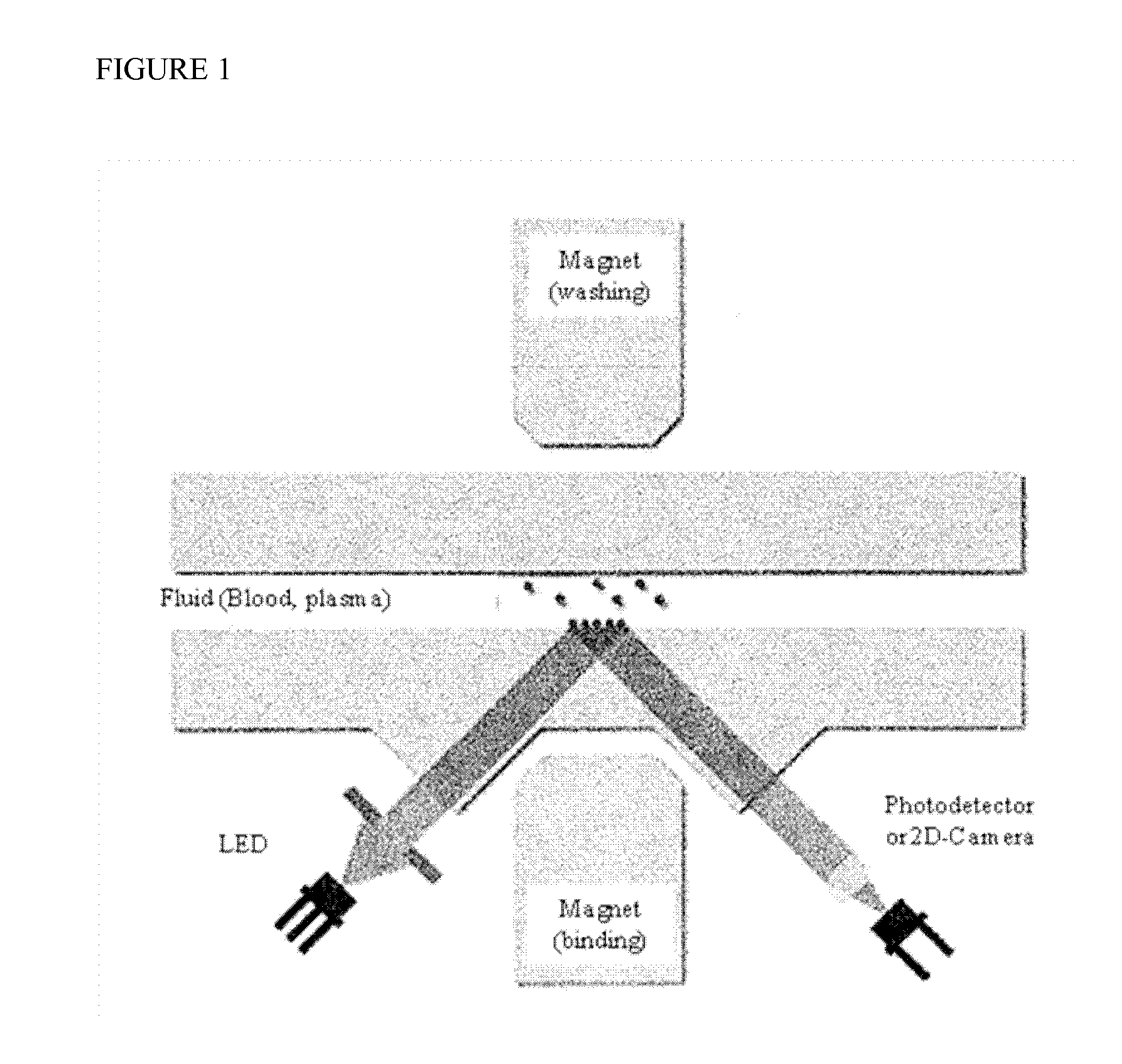Method for detection of coagulation activity and biomarkers
a biomarker and coagulation activity technology, applied in the field of coagulation activity and biomarkers detection, can solve the problems of inconvenient clinical application, thrombosis in the venous system, acute death, etc., and achieve the effect of saving costs and time, facilitating correct conclusions regarding suitable medication, and sufficient and accurate results
- Summary
- Abstract
- Description
- Claims
- Application Information
AI Technical Summary
Benefits of technology
Problems solved by technology
Method used
Image
Examples
example 1
Measurement of Coagulation Activity by Determining Clotting Time of a Plasma Sample Using an Optomagnetic Assay
[0120]The coagulation cascade in plasma typically results in formation of fibrin networks which hamper the movement of magnetic nanoparticles in the liquid to be tested. An exemplary measurement of clotting time according to the invention is carried out on the Magnotech®-biosensor system using a detection based on frustrated total internal reflection (FTIR). The experimental setup is depicted in FIG. 1. Magnetic actuation of the magnetic particles occurs via the alternate action of two magnets, i.e. an upper magnet (washing magnet) and a lower magnet (binding magnet). The clotting time in this example is measured utilizing a standard Magnotech® biosensor cartridge for FTIR detection and 500 nm superparamagnetic beads. Likewise the beads may be already provided within a biosensor cartridge or added together with the blood sample mixture.
[0121]In this Example, a mixture of 5 ...
example 2
Measurement of Coagulation Activity by Determining Clotting Time of a Whole Blood Sample using an Optomagnetic Assay
[0125]The same measurement as exemplified in Example 1 can be carried out using a whole blood sample instead of plasma. Although whole blood sample comprises blood cells, preliminary tests have shown that the free movement of the magnetic particles are not compromised by the presence of hematocrit. Using the experimental setup as shown in FIG. 1, 5 μl of a whole blood sample is injected into the sample container already comprising the 500 nm superparamagnetic beads and the change in light signal is measured over time. The time period between injection (time point 0) and change in light signal corresponds to the clotting time and serves as measure of coagulation activity.
example 3
Simultaneous Measurement of Coagulation Activity by Determining Clotting Time of a Citrated Blood Sample and of the Presence / Amount of a Coagulation Unrelated Biomarker Troponin-I using an Optomagnetic Assay
[0126]Example 1 and 2 demonstrate that coagulation activity can be successfully measured using an optomagnetic device as described in FIG. 1. In order to assess whether a simultaneous measurement using the same cartridge comprising superparamagnetic beads functionalized with a binding molecule directed against a coagulation unrelated biomarker within the blood sample is feasible, 5 μl citrated plasma is injected with or without 5 μl 0.125 M CaCl2 in PBS into a sample container containing 500 nm superparamagnetic beads which surface is covered with an antibody directed against the biomarker Troponin-I. Immediately after injection magnetic actuation is started and the biomarker is detected as a round spot on the cartridge surface within about 2 to 3 minutes after injection. The mea...
PUM
 Login to View More
Login to View More Abstract
Description
Claims
Application Information
 Login to View More
Login to View More - R&D
- Intellectual Property
- Life Sciences
- Materials
- Tech Scout
- Unparalleled Data Quality
- Higher Quality Content
- 60% Fewer Hallucinations
Browse by: Latest US Patents, China's latest patents, Technical Efficacy Thesaurus, Application Domain, Technology Topic, Popular Technical Reports.
© 2025 PatSnap. All rights reserved.Legal|Privacy policy|Modern Slavery Act Transparency Statement|Sitemap|About US| Contact US: help@patsnap.com



